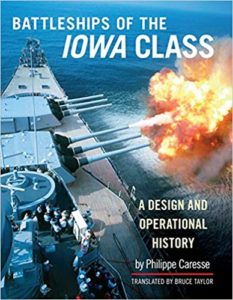 Reviewed by Mr. Charles Bogart
Reviewed by Mr. Charles Bogart
Philippe Caresse is a former French naval officer and author of two books on French warships of the World War I, both of which were published by the Naval Institute Press. The book under review, Battleships of the Iowa Class, can be enjoyed both as a coffee table book and as a penetrating examination of the design, construction, and operational history of the Iowa Class. The book is divided into two equal sections: technical and operational. The technical section examines the design and construction of the Iowa Class: Iowa BB 61, New Jersey BB 62, Missouri BB 63, Wisconsin BB 64, Illinois BB 65, and Kentucky BB 66. The second section covers the operational history of the four Iowa Class ships that were commissioned. There is also an interesting chapter on the fate of Illinois and Kentucky, the two Iowa Class ships that were not completed.
The technical section delves into the genesis and design development of the Iowa Class. The introductory chapter is well worth reading as it sets out the Washington Treaty constraints that limited the offensive power of the South Dakota Class as compared to the Iowa Class whose offensive powers was only limited by the constraints of navigating the Panama Canal. Topics covered in this section are ship characteristics, armament, power and propulsion plant, shipboard equipment, camouflage paint, retrofitting, and conversion projects. Each of these topics are covered in their own chapter and add to the mystic of the Iowa Class. This section ends with a chapter entitled “Preservation and Legal Status,” which gives one a basic understanding of the complications one can encounter in trying to preserve a U.S. Navy warship. The author has seen fit to tell the story of the design and construction of these ships using superb artistic renderings, excellent line drawings, and outstanding photographs, all of which provides the reader with a visual understanding of what is being discussed in the text.
The second section covers the operational lives of the four commissioned Iowa Class battleships. The author recounts in some detail their service in World War II, Korean War, Vietnam War, and Desert Storm. The commissioned life of all four battleships is summarized in a quote made by Rear Admiral Abhau concerning New Jersey. “We were part of antiaircraft protection. We did a good deal of shore bombardment. We also served as an underway refueling ship and a hospital ship. In fact, we did everything except be a battleship.”
This book can also be enjoyed as a coffee table photo book. While the book has numerous standard black and white photos of the four ships, it is the pages of color photos which sets this book apart. Some of these photos are worthy of display in an art gallery. In total, the photo coverage provided in this book of the four Iowa Class ships leaves very little of their internal and external spaces not illustrated.
This book is sure to become the benchmark by which all other books on the Iowa Class will be judged.
The Battleships of the Iowa Class – A Design and Operational History, by Philippe Caresse. Translated by Bruce Taylor. 2019, Naval Institute Press, Annapolis, MD. 522 pp., $120.00
Review by Mr. Charles Bogart, NHF Member and frequent reviewer.
Purchase your copy today! Naval Institute members get a 40 percent discount on purchasing this book.


Don Helgeson